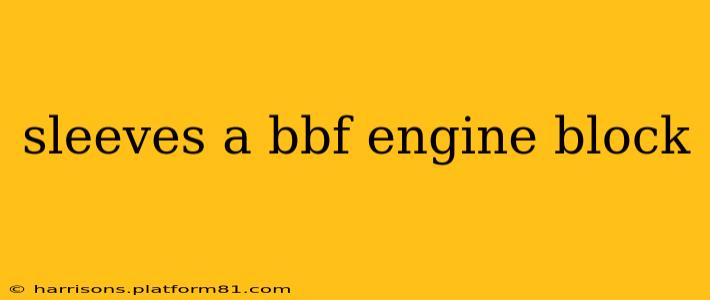The Ford 429/460 Big Block Ford (BBF) engine, known for its robust power and torque, is a favorite among enthusiasts. However, years of use or high-performance modifications can sometimes lead to cylinder wall wear, necessitating a rebuild. Sleeving the engine block is a crucial step in this process, offering a cost-effective way to restore cylinder integrity and extend the engine's lifespan. This comprehensive guide will delve into the intricacies of sleeving a BBF engine block, addressing common questions and concerns.
What is Sleeving an Engine Block?
Sleeving an engine block involves installing precisely manufactured steel liners, or "sleeves," inside the worn cylinders. These sleeves restore the cylinder's original diameter and surface finish, creating a new, smooth bore for the pistons to operate within. This process is particularly beneficial when cylinder walls are excessively worn, scored, or damaged beyond repair through honing or other less invasive methods. Essentially, you're creating a new cylinder within the old block.
Why Sleeve a BBF Engine Block Instead of Boring?
Boring out the existing cylinders to a larger size, while a viable option in some cases, has limitations. Excessive boring can weaken the cylinder walls, potentially leading to future issues. Sleeving avoids this by utilizing the original cylinder's outer wall for structural support, maintaining the block's overall strength and rigidity. This is especially important with a large-displacement engine like the BBF, where maintaining block integrity is paramount.
What are the Different Types of Sleeves?
Several types of sleeves are available, each with its own advantages and disadvantages:
-
Dry-type sleeves: These sleeves are pressed into the block without the use of any sealant. They rely on a precise interference fit to maintain a secure position. Their installation requires precise machining of both the sleeve and the cylinder bore.
-
Wet-type sleeves: These sleeves are installed using a sealant or adhesive to create a watertight seal between the sleeve and the block. This can simplify installation in some instances, but proper sealant selection and application are critical.
How Much Does Sleeving a BBF Engine Block Cost?
The cost of sleeving a BBF engine block varies significantly depending on several factors, including:
- The shop performing the work: Labor rates differ widely across geographic locations and the expertise of the machine shop.
- The type of sleeves used: Higher-quality, more durable sleeves will generally cost more.
- The condition of the block: Blocks requiring extensive preparation work will increase the overall cost.
- Additional services: Machining other components, such as the crankshaft and cylinder heads, can inflate the total expenses.
Generally, expect to pay a substantial sum for professional sleeving. It's a specialized job that requires precision and skill, making it an investment rather than a cheap repair.
Can I Sleeve My BBF Engine Block Myself?
Sleeving an engine block is a highly technical procedure that demands precision machining and specialized equipment. Attempting to sleeve a block without the proper tools and expertise is strongly discouraged. Improper sleeving can lead to catastrophic engine failure. It's best to entrust this critical task to experienced engine machinists.
What are the Benefits of Sleeving a BBF Engine Block?
Sleeving offers numerous advantages:
- Extended engine life: Sleeving essentially gives your engine a new set of cylinders, significantly extending its usable life.
- Increased strength and durability: The steel sleeves provide additional strength and resistance to wear, particularly beneficial for high-performance applications.
- Improved cylinder roundness and surface finish: Sleeves ensure perfectly round and smooth cylinders, improving piston ring seal and reducing friction.
- Cost-effective repair: In many cases, sleeving is more cost-effective than replacing the entire engine block.
How Long Does Sleeving a BBF Engine Block Take?
The time required to sleeve a BBF engine block can vary based on the machine shop's workload and the block's condition. However, expect a multi-day process, involving machining, sleeve installation, and final inspection. Always discuss expected completion time with your chosen machine shop before initiating the work.
In conclusion, sleeving a BBF engine block is a significant undertaking requiring professional expertise. However, when executed correctly, it provides a reliable and cost-effective method to restore a damaged block to its former glory, extending the life and performance of your powerful Big Block Ford engine. Remember to always consult with a reputable engine machine shop for assessment and guidance.
